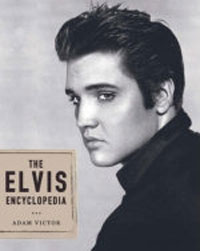The Elvis Encyclopedia was created to help bring order to the massive amount of material written about Elvis Presley. In doing so, it stands as the most comprehensive book about his extraordinary life and legacy ever published. It is also a visual compendium of Elvis' life, offering hundreds of photographs, ranging from never-before-seen private moments to the extraordinary iconic images the world has come to love. A definitive one-stop resource for fans and scholars.
The Elvis Enclycopedia
Book

ElvisNews review
How to review an 608 pages Elvis Presley encyclopedia? Alphabetical according to Neil Genzlinger from the NY Times. Alphabetical is how the entries are listed in “The Elvis Encyclopedia,” a mammoth new survey of all things King by Adam Victor, the author of “The Marilyn Encyclopedia.”
ALPHABETICAL
Alphabetical is how the entries are listed in “The Elvis Encyclopedia,” a mammoth new survey of all things King by Adam Victor, the author of “The Marilyn Encyclopedia.”
BOO-YA!
“Boo-ya!” is the expression of triumph a critic utters when assigned to review something like “The Elvis Encyclopedia,” because he knows that the book is essentially critic-proof and that he therefore need not bring any intellectual heft to the gig; instead, he can quickly dispose of the assignment using some cheesy gimmick.
COLONEL
The encyclopedia, a coffee-table book, is laid out in columns, three to a page, and Colonel Thomas Andrew Parker, Presley’s manager-exploiter, receives 252 column inches of type, far more than anyone or anything else. Other high-inch-count entries trace the spectacular, sad Elvis arc: RCA Records, 122 inches; fans, 78 inches; girlfriends, 68 inches; Priscilla, 92 inches; money, 65 inches; health, 63 inches; drugs, 70 inches; death, 89 inches.
DON’T
A good way to approach this sprawling book is to scan for quirkiness. For instance, nine entries begin with “Don’t” (not including a “Doncha’ ”), all of them titles of songs. The one that mattered: “Don’t Be Cruel,” recorded on July 2, 1956, and, with “Hound Dog” on the flip side, a musical revolution.
EDITING
Editing is what this book didn’t have enough of. It’s full of typographical errors and clunky phrasings, so many that you may wonder how reliable its facts are.
FRIED
How Elvis preferred a lot of his food, and how you’ll feel if you read too much of this avalanche of minutiae in one sitting.
GLASSES
Glasses are what anyone alive during Elvis’s prime will need to read this book, which chose quantity over type size.
HUMOR
Humor is what this book seems to have almost no sense of. It generally delivers its facts colorlessly, tone-deaf to its own surprises. One of the funniest things in it is inadvertent. A full-page still from “Girls! Girls! Girls!” shows Elvis, among the most famous faces in history, surrounded by dancing women, a lone male in a phalanx of females. The caption reads, “Elvis, in center. . . .” Thanks for pointing that out.
ILLUSTRATIONS
The book is lavishly and lovingly illustrated with candid photos, movie stills, posters and assorted oddities. Best of the bunch: the cover of a 1950s magazine called True Strange, which asked that eternal question: “Did the Devil Send Elvis Presley?”
JEWELRY, KARATE
Elvis liked jewelry, and he liked karate. It was not a trouble-free combination. Back in the ’70s he wore a ludicrous number of rings, and “every once in a while one of them would bounce off during a particularly energetic karate move.”
LAST
Most unnecessary cross-reference in the book:
Last Day Alive
See Death
MIRED
Thirty-one years after Elvis’s death, mired in the past is what you may feel a lot of people are after you have read the entry “Fan Club List in the 2000s,” which simply provides names of Elvis fan clubs. It consumes 82 column inches yet admits that it is “somewhat incomplete.” Sample names: Grazie Elvis (Italy), Elvis Is in Istanbul Now (Turkey), Snorkeling Elvises (Florida).
NIXON, OTHER
The Nixon you’re expecting is here — Elvis’s somewhat deranged letter to the president offering to help in the drug wars is reproduced — but almost as amusing is the Other Nixon: Hershel. The book relates that in 1957 he said in a lawsuit that Elvis had threatened him with a gun. There was an out-of-court settlement and an apology from Elvis, who claimed he had merely been showing some pals a prop pistol. It’s not easy being King.
POLLUTION
How much did Elvis contribute to global warming with all those big cars he gave away? The book leaves the issue unexplored. But it does catalog his generosity, which bordered on the pathological.
QUOTATIONS
In a nice touch, the book throws in relevant quotations after many entries, by Elvis or about him. After the “Sinatra, Frank” entry, for example, is a snippet of Sinatra’s assessment of Elvis early on: “His kind of music is deplorable, a rancid-smelling aphrodisiac.”
RECURRING SPINAL TRAUMA
Recurring spinal trauma is what you’ll have if your daily commute includes lugging around this book, which weighs more than Elvis himself.
ÜBER-VEGAS
The encyclopedia has five separate entries for “Viva Las Vegas”: song, EP, LP, live LP, movie. It also has entries for Las Vegas, Las Vegas Hilton and Nevada (which lapses immediately into a subheading: Las Vegas).
WARHOL
A gorgeous full-page Elvis Wheaties box, never issued but reproduced here, could, and should, have been painted by Andy Warhol.
X
Only the letter “X” has no entries in the encyclopedia.
YOUNG
In, perhaps, a subliminal resolution of the longstanding debate over whether young Elvis or older Elvis was better, the book has seven entries beginning with “Young”: four people and three songs. Only two, both songs, begin with “Old”: “Old MacDonald” and “Old Shep.”
ZEPPELIN
The book gives a brief quotation from Robert Plant of Led Zeppelin, who met Elvis in Las Vegas in 1973, and it sums up the man as succinctly as anything in these 600 pages: “He knew that he was locked in this self-parody.